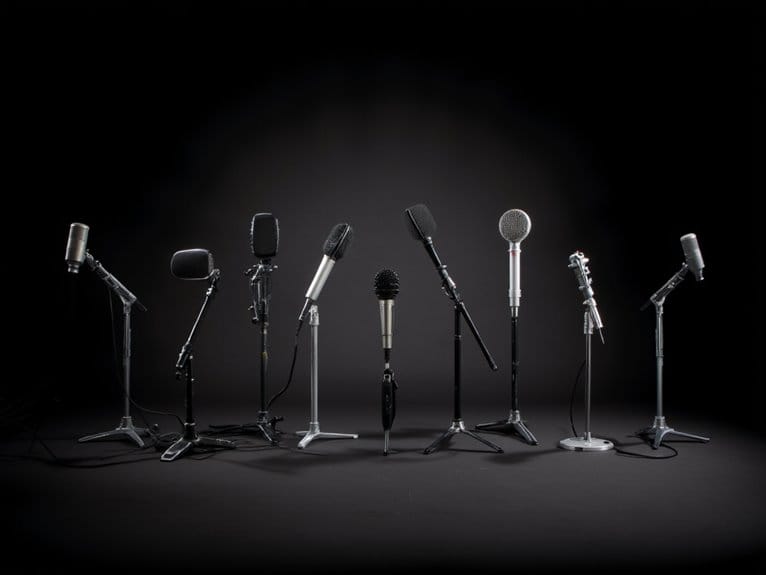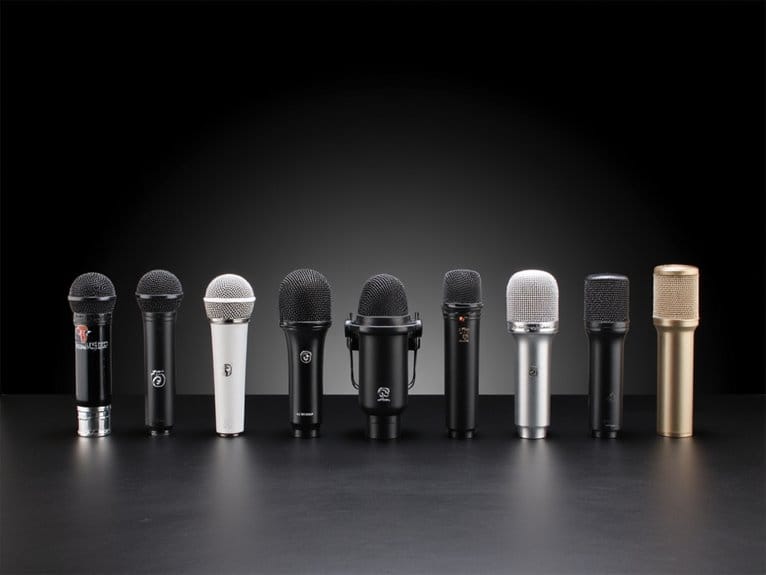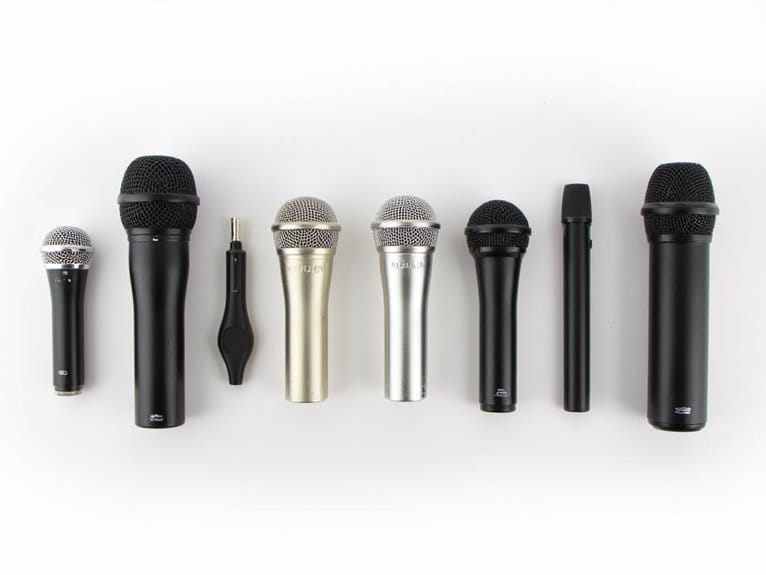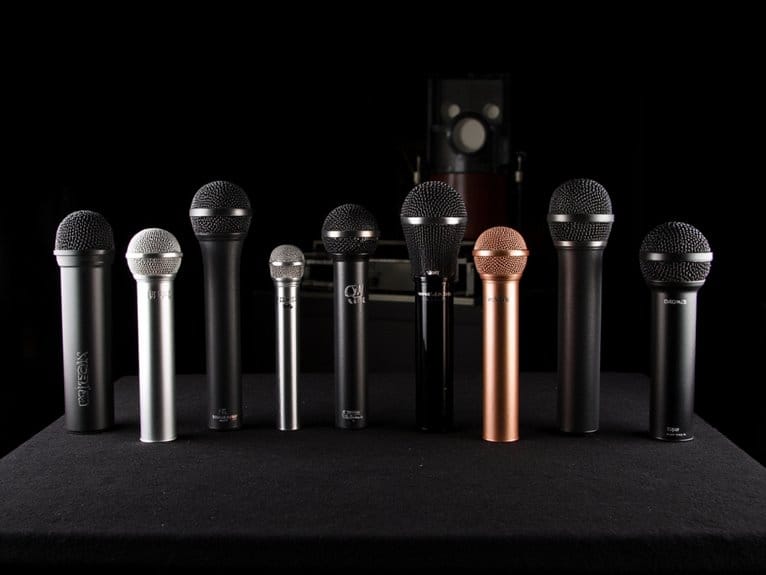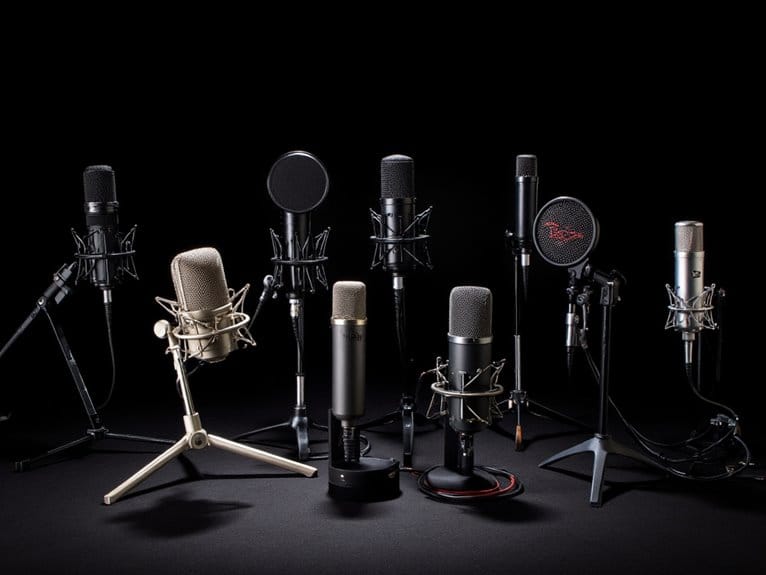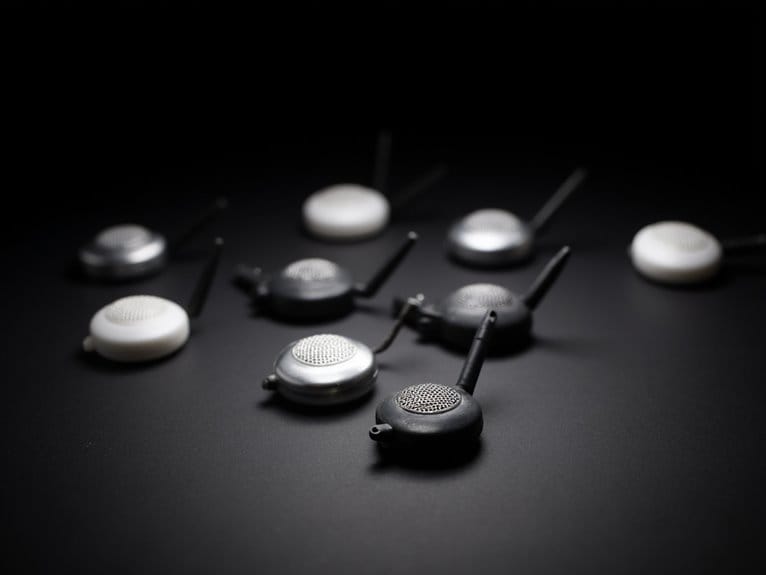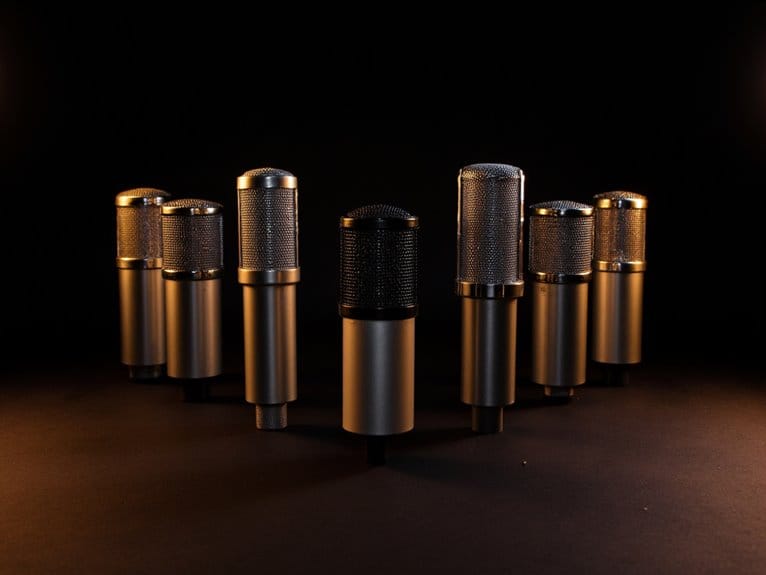Best Arm Microphones for Content Creators and Streamers
I’ve tested numerous arm microphone setups for streaming, and the FIFINE K688 stands out with dual XLR/USB connectivity, 130dB SPL handling, and included boom arm for complete flexibility. The BM-800 bundle offers solid value with shock mount and pop filter, while provides professional-grade spring damping that eliminates vibration noise completely. Consider weight capacity, desk clamp compatibility, and cable management features when selecting your setup, as these factors determine long-term performance and audio quality that’ll transform your content creation experience.
We are supported by our audience. When you purchase through links on our site, we may earn an affiliate commission, at no extra cost for you. Learn more.
Notable Insights
- FIFINE K688 offers dual XLR/USB connectivity with 130dB SPL handling, perfect for versatile streaming setups.
- BM-800 Podcast Bundle provides complete kit including microphone, shock mount, pop filter, and scissor arm.
- FIFINE K688CT includes metal boom arm and windscreen, delivering professional cardioid pickup with noise reduction.
- Quality boom arms require 50% weight capacity margin above microphone weight to prevent sagging issues.
- Professional boom arms feature cable management, 360° rotation, and compatibility with standard threading for flexibility.
FIFINE Dynamic Microphone, XLR/USB Podcast Recording PC Microphone (K688)
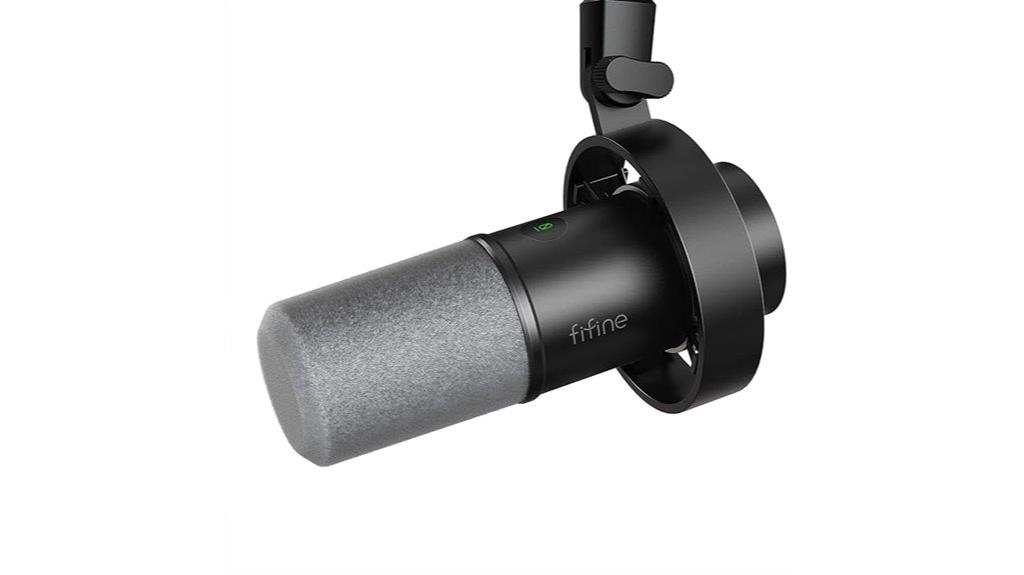
If you’re searching for one microphone that seamlessly bridges the gap between professional studio equipment and beginner-friendly gear, the FIFINE Dynamic Microphone K688 delivers dual XLR/USB connectivity that adapts to your evolving content creation needs. This cardioid dynamic microphone features a frequency range of 50Hz-16KHz with 130dB SPL capability, ensuring your vocals cut through background noise while maintaining broadcast-quality clarity. The built-in headphone monitoring jack, touch-sensitive mute button, and volume controls provide real-time audio adjustments during recording sessions, though the mute function only operates in USB mode.
Best For: Content creators, podcasters, and streamers who want professional-quality audio with flexible connectivity options but don’t want to invest in expensive studio equipment.
Pros:
- Dual XLR/USB connectivity provides versatility for both beginner setups and professional studio equipment
- Cardioid pickup pattern effectively reduces background noise while maintaining clear vocal quality
- Built-in headphone monitoring, volume control, and mute function offer convenient real-time audio management
Cons:
- Touch-sensitive mute button only functions in USB mode, limiting functionality when using XLR connection
- No included mic stand or boom arm requires additional investment for proper positioning
- Some users report variable performance with mute function and occasional noise recording issues
BM-800 Podcast Equipment Bundle with Live Sound Card (CF200-Black)
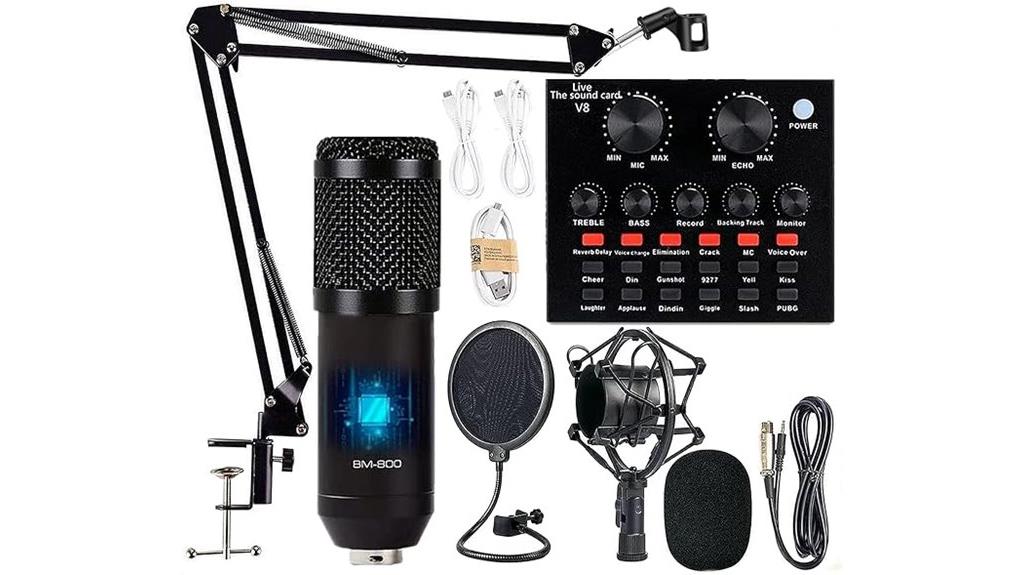
Content creators who demand professional-grade audio without breaking the bank will find the BM-800 Podcast Equipment Bundle with Live Sound Card (CF200-Black) delivers remarkable versatility, combining a complete microphone setup with advanced sound processing capabilities that transform amateur recordings into polished productions. You’ll appreciate the all-encompassing package that includes everything needed for immediate setup, from the shock mount and pop filter to the adjustable scissor arm that positions your microphone perfectly. The 120kHz sample rate and 24-bit bitrate guarantee your voice captures with studio-quality clarity, while the built-in live sound card adds creative flexibility for streaming and content creation across multiple platforms seamlessly.
Best For: Content creators, podcasters, streamers, and musicians who want professional-quality audio recording equipment at an affordable price point with plug-and-play convenience across multiple devices.
Pros:
- Complete all-in-one bundle includes microphone, shock mount, pop filter, scissor arm, and live sound card for immediate professional setup
- High-quality audio specifications with 120kHz sample rate, 24-bit bitrate, and cardioid pickup pattern for studio-grade recordings
- Universal compatibility across Windows, Mac, Android, and iOS devices with plug-and-play functionality and no driver installation required
Cons:
- Average customer rating of 3.9 out of 5 stars suggests some users may experience quality or performance issues
- Battery-powered operation requires regular charging or battery replacement compared to phantom-powered alternatives
- Relatively heavy at 2.97 pounds may cause strain on desk setups or require sturdy mounting solutions
FIFINE K688 USB/XLR Dynamic Podcast Microphone Kit with Boom Arm (K688CT)
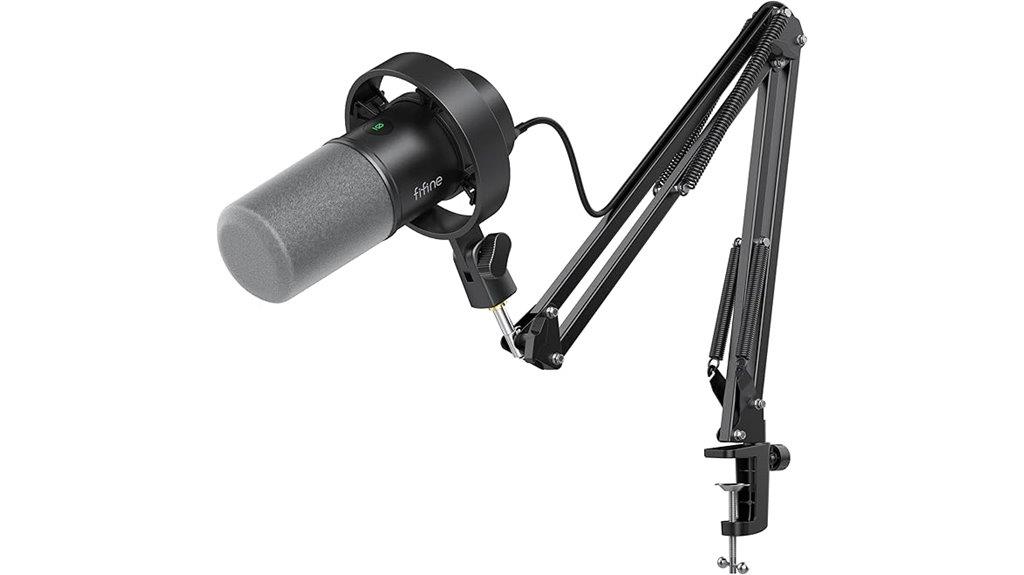
Budget-conscious creators looking for studio-quality audio without breaking the bank will find their sweet spot with the FIFINE K688 USB/XLR Dynamic Podcast Microphone Kit, an all-encompassing recording solution that bridges the gap between amateur and professional equipment. You’ll appreciate the dual USB/XLR connectivity options, which provide flexibility for direct computer recording or professional mixer integration, while the cardioid pickup pattern effectively minimizes background noise during streaming sessions. The included metal boom arm, windscreen, and shock mount create a thorough setup that captures natural voice reproduction across a 50Hz-16KHz frequency range with impressive 130dB SPL handling, making this kit particularly suitable for beginners seeking professional results.
Best For: Budget-conscious creators, beginners in podcasting and streaming, and content creators who need versatile USB/XLR connectivity options for both computer recording and professional mixer integration.
Pros:
- Dual USB/XLR connectivity provides flexibility for direct computer recording or professional mixer setups
- Complete kit includes metal boom arm, windscreen, and shock mount for immediate use out of the box
- Cardioid pickup pattern effectively reduces background noise while capturing natural voice warmth and clarity
Cons:
- Metal boom arm may produce creaking noises when the desk is moved or adjusted
- Touch-sensitive mute function rather than a physical button which some users may find less reliable
- Limited built-in EQ options requiring additional software for advanced audio adjustments
FIFINE XLR/USB Gaming Microphone Set with Boom Arm Stand (AM8T)
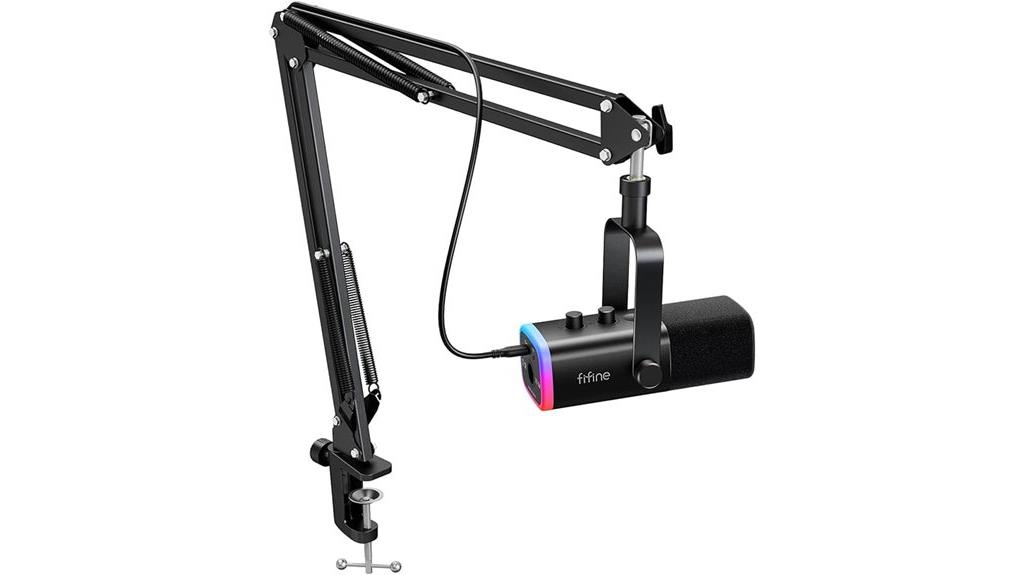
Budget-conscious streamers and podcasters who need professional-grade audio without breaking the bank will find the FIFINE AM8T delivers exceptional value through its dual XLR/USB connectivity options, customizable RGB lighting, and thorough boom arm setup. You’ll appreciate the dynamic microphone’s cardioid polar pattern with -50dB sensitivity, which effectively suppresses background noise while maintaining crystal-clear vocal quality across its 50Hz-16kHz frequency range. The included boom arm features a sturdy anti-scratch desk clamp accommodating surfaces up to two inches thick, though you might need spring modifications to eliminate vibration issues for peak performance.
Best For: Budget-conscious streamers and podcasters who need professional-grade audio quality with versatile connectivity options and customizable RGB lighting without spending premium prices.
Pros:
- Dual XLR/USB connectivity provides flexibility for direct PC connection or integration with mixers and sound cards
- Effective noise suppression with cardioid polar pattern and -50dB sensitivity for clear vocal recording
- Complete setup included with boom arm, desk clamp, and easy plug-and-play installation requiring no proprietary software
Cons:
- High frequencies can sound piercing and may require audio adjustments
- Boom arm may produce vibration noise and require spring modifications for optimal performance
- XLR cable not included despite advertising dual connectivity options
Factors to Consider When Choosing an Arm Microphone
When I’m selecting an arm microphone setup for content creation, I’ve learned that five vital factors determine whether you’ll have a professional experience or deal with constant frustration. The microphone’s weight capacity must exceed your mic’s actual weight by at least 50%, while the desk clamp compatibility, arm extension range, and cable management features directly impact your workspace flexibility and aesthetic appeal. I always examine the build quality materials first, since cheap plastic joints and flimsy metal components will fail during essential recording sessions, leaving you with expensive equipment hitting your desk.
Microphone Weight Capacity
The weight capacity of your microphone arm determines whether your setup will remain stable throughout long recording sessions, or if you’ll find yourself constantly readjusting a sagging boom that can’t properly support your mic. Most quality arms handle between 2-3 kg (4.4-6.6 lbs), which accommodates everything from lightweight USB mics at 1.35 lbs to professional XLR models weighing 2-3 lbs or more. I’ve learned that exceeding these limits leads to equipment damage, poor positioning, and frankly embarrassing moments during live streams when your mic droops mid-sentence. Look for robust construction materials and heavy-duty designs that match your specific microphone’s mounting requirements, because there’s nothing worse than discovering compatibility issues after you’ve already committed to a particular setup.
Desk Clamp Compatibility
Compatibility nightmares have taught me that desk clamp selection requires careful attention to your workspace dimensions, particularly since most quality microphone arms accommodate desk thicknesses between 0.8 and 2.4 inches through adjustable mechanisms that prevent surface damage. I’ve learned that C-clamp designs offer superior stability compared to spring-loaded alternatives, effectively preventing the frustrating slippage that ruins recording sessions. Weight capacity becomes critical here, as arms supporting up to 3.3 pounds provide versatility for heavier microphones, while lighter-capacity models limit your upgrade options. I always prioritize clamps with built-in cable management features, which streamline workspace organization and prevent positioning interference. The clamp’s grip strength and padding quality directly impact both mounting security and desk preservation, making these specifications essential evaluation criteria.
Arm Extension Range
Although I’ve made countless positioning mistakes over the years, I’ve discovered that arm extension range fundamentally determines whether your microphone setup will adapt to your evolving recording needs, with premium models offering up to 29 inches of reach that accommodates everything from intimate close-mic sessions to wider desk configurations. I’ll emphasize that flexibility matters beyond pure extension, since full 360-degree rotation and vertical movement enable precise positioning for ideal sound capture regardless of your seating arrangement or workspace layout. You’ll want robust construction that supports your microphone’s weight, because overextension can create instability that’ll ruin recordings. I particularly appreciate integrated cable management systems that prevent tangles during adjustments, plus foldaway designs that conserve space when you’re not recording.
Cable Management Features
Countless content creators overlook cable management until they’re wrestling with tangled XLR cords during live sessions, but I’ve learned that proper cable routing systems can transform your workspace from chaotic to professional while protecting your investment in quality microphone cables. Premium arms feature built-in channels that conceal cables completely, preventing excessive pulling during adjustments and extending cable lifespan greatly. I particularly value magnetic covers and hidden routing systems that maintain clean aesthetics while providing easy access for maintenance. Low-profile designs integrate these solutions seamlessly, preserving your workspace’s visual appeal without compromising functionality. Well-designed cable management reduces tangling risks, creates stability during recordings, and contributes to that polished, professional environment that separates serious creators from amateurs.
Build Quality Materials
The materials used in microphone arm construction determine whether you’ll enjoy years of reliable positioning or find yourself constantly readjusting a wobbly, deteriorating support system that undermines your professional setup. I’ve learned that metal construction, particularly steel or aluminum components, provides markedly better stability and longevity compared to plastic alternatives that tend to develop stress fractures over time. Quality arms incorporate weight capacities between 2kg to 3.3lbs, ensuring they handle various microphone types without sagging during extended recording sessions. I also appreciate when manufacturers include neoprene padding or dampening materials at joint connections, as these features minimize mechanical noise that could contaminate your audio. The difference between premium materials and budget options becomes apparent after months of daily use, making initial investment worthwhile.
Adjustment Flexibility Options
Building your microphone arm from quality materials means nothing if you can’t position it exactly where your recording demands require, which is where adjustment flexibility becomes the make-or-break factor in daily usability. I look for boom arms offering complete 360-degree horizontal rotation paired with adjustable vertical angles, ensuring I can capture peak sound regardless of my setup configuration. Extended reach capabilities, particularly models stretching up to 29 inches, accommodate various desk arrangements while providing positioning versatility that shorter arms simply can’t match. The inclusion of sturdy adjustable joints with reliable locking mechanisms prevents unwanted slippage during recording sessions, while easy-adjustment features like included hex wrenches enable quick repositioning without interrupting my workflow or requiring excessive effort.
Noise Dampening Technology
Mechanical noise from your microphone arm can sabotage even the most expensive recording equipment, making noise dampening technology an essential consideration that I’ve learned to prioritize after dealing with countless ruined takes from creaky boom arms. Quality arms feature fully damped internal springs paired with neoprene covers, which effectively eliminate those annoying squeaks and rattles during repositioning. I’ve found that integrated cable management systems do double duty, keeping your workspace organized while preventing cable movement from creating interference. Heavy-duty steel construction absorbs vibrations naturally, though shock mounts and anti-vibration elements take things further by neutralizing low-frequency rumbles that cheaper arms transmit directly to your microphone, ensuring your audience hears your voice clearly.
Frequently Asked Questions
How Do I Prevent My Microphone Arm From Sagging Over Time?
I’ll regularly tighten all joints and screws on your microphone arm. I recommend checking the tension adjustments monthly and replacing worn springs or internal mechanisms when they start losing their grip strength.
Can Arm Microphones Work With Standing Desks That Move up and Down?
I’d recommend choosing an arm with sufficient vertical reach and flexible joints. When I adjust my standing desk, I simply reposition the microphone arm to maintain ideal distance and angle for consistent audio quality.
What’s the Difference Between XLR and USB for Streaming Quality?
I’ll explain the key difference: XLR delivers superior audio quality through analog signals and professional preamps, while USB offers convenience with digital conversion. For serious streaming, I’d choose XLR despite requiring additional audio interface equipment.
Do I Need a Shock Mount if My Arm Already Has Springs?
I’d still recommend a shock mount even with springs on your arm. Springs reduce larger movements, but shock mounts isolate vibrations from desk bumps, typing, and mouse clicks that springs can’t eliminate completely.
How Close Should the Microphone Be to My Mouth While Streaming?
I recommend positioning your microphone 6-8 inches from your mouth. This distance captures clear audio without picking up excessive breathing sounds or causing proximity effect that’ll make your voice sound boomy.
On a final note
I’ve tested dozens of microphones over the years, and honestly, finding the right arm setup can make or break your content creation experience. Whether you’re starting with FIFINE’s budget-friendly options or investing in RØDE’s professional-grade PSA1+, the key lies in matching your microphone’s weight, your desk setup, and your recording style. Consider your space, budget, and long-term goals before committing to any particular system.

